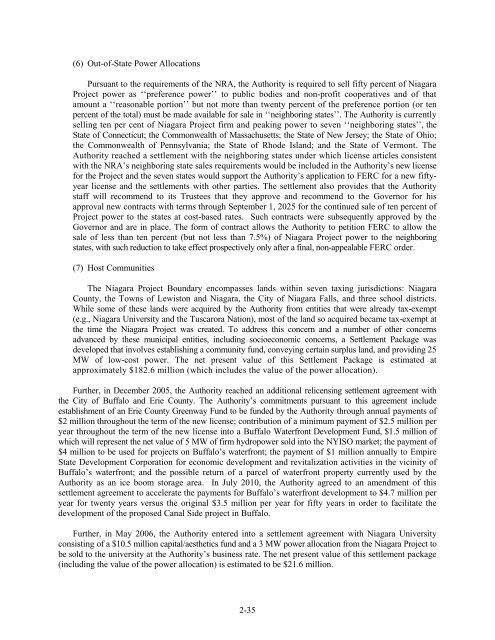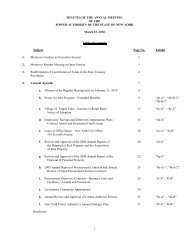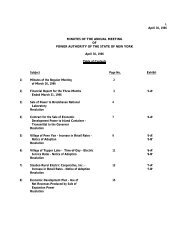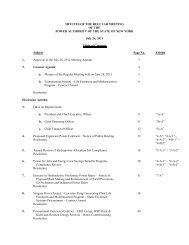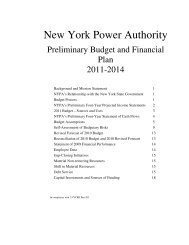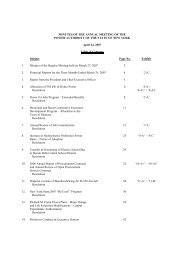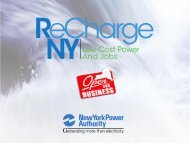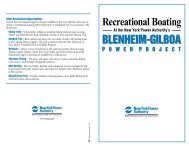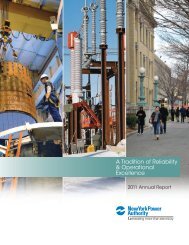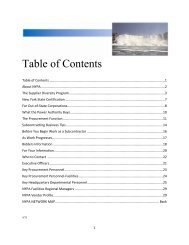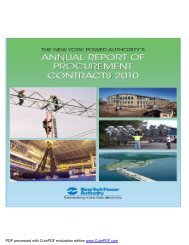July (pdf) - New York Power Authority
July (pdf) - New York Power Authority
July (pdf) - New York Power Authority
You also want an ePaper? Increase the reach of your titles
YUMPU automatically turns print PDFs into web optimized ePapers that Google loves.
(6) Out-of-State <strong>Power</strong> Allocations<br />
Pursuant to the requirements of the NRA, the <strong>Authority</strong> is required to sell fifty percent of Niagara<br />
Project power as ‘‘preference power’’ to public bodies and non-profit cooperatives and of that<br />
amount a ‘‘reasonable portion’’ but not more than twenty percent of the preference portion (or ten<br />
percent of the total) must be made available for sale in ‘‘neighboring states’’. The <strong>Authority</strong> is currently<br />
selling ten per cent of Niagara Project firm and peaking power to seven ‘‘neighboring states’’, the<br />
State of Connecticut; the Commonwealth of Massachusetts; the State of <strong>New</strong> Jersey; the State of Ohio;<br />
the Commonwealth of Pennsylvania; the State of Rhode Island; and the State of Vermont. The<br />
<strong>Authority</strong> reached a settlement with the neighboring states under which license articles consistent<br />
with the NRA’s neighboring state sales requirements would be included in the <strong>Authority</strong>’s new license<br />
for the Project and the seven states would support the <strong>Authority</strong>’s application to FERC for a new fiftyyear<br />
license and the settlements with other parties. The settlement also provides that the <strong>Authority</strong><br />
staff will recommend to its Trustees that they approve and recommend to the Governor for his<br />
approval new contracts with terms through September 1, 2025 for the continued sale of ten percent of<br />
Project power to the states at cost-based rates. Such contracts were subsequently approved by the<br />
Governor and are in place. The form of contract allows the <strong>Authority</strong> to petition FERC to allow the<br />
sale of less than ten percent (but not less than 7.5%) of Niagara Project power to the neighboring<br />
states, with such reduction to take effect prospectively only after a final, non-appealable FERC order.<br />
(7) Host Communities<br />
The Niagara Project Boundary encompasses lands within seven taxing jurisdictions: Niagara<br />
County, the Towns of Lewiston and Niagara, the City of Niagara Falls, and three school districts.<br />
While some of these lands were acquired by the <strong>Authority</strong> from entities that were already tax-exempt<br />
(e.g., Niagara University and the Tuscarora Nation), most of the land so acquired became tax-exempt at<br />
the time the Niagara Project was created. To address this concern and a number of other concerns<br />
advanced by these municipal entities, including socioeconomic concerns, a Settlement Package was<br />
developed that involves establishing a community fund, conveying certain surplus land, and providing 25<br />
MW of low-cost power. The net present value of this Settlement Package is estimated at<br />
approximately $182.6 million (which includes the value of the power allocation).<br />
Further, in December 2005, the <strong>Authority</strong> reached an additional relicensing settlement agreement with<br />
the City of Buffalo and Erie County. The <strong>Authority</strong>’s commitments pursuant to this agreement include<br />
establishment of an Erie County Greenway Fund to be funded by the <strong>Authority</strong> through annual payments of<br />
$2 million throughout the term of the new license; contribution of a minimum payment of $2.5 million per<br />
year throughout the term of the new license into a Buffalo Waterfront Development Fund, $1.5 million of<br />
which will represent the net value of 5 MW of firm hydropower sold into the NYISO market; the payment of<br />
$4 million to be used for projects on Buffalo’s waterfront; the payment of $1 million annually to Empire<br />
State Development Corporation for economic development and revitalization activities in the vicinity of<br />
Buffalo’s waterfront; and the possible return of a parcel of waterfront property currently used by the<br />
<strong>Authority</strong> as an ice boom storage area. In <strong>July</strong> 2010, the <strong>Authority</strong> agreed to an amendment of this<br />
settlement agreement to accelerate the payments for Buffalo’s waterfront development to $4.7 million per<br />
year for twenty years versus the original $3.5 million per year for fifty years in order to facilitate the<br />
development of the proposed Canal Side project in Buffalo.<br />
Further, in May 2006, the <strong>Authority</strong> entered into a settlement agreement with Niagara University<br />
consisting of a $10.5 million capital/aesthetics fund and a 3 MW power allocation from the Niagara Project to<br />
be sold to the university at the <strong>Authority</strong>’s business rate. The net present value of this settlement package<br />
(including the value of the power allocation) is estimated to be $21.6 million.<br />
2-35


